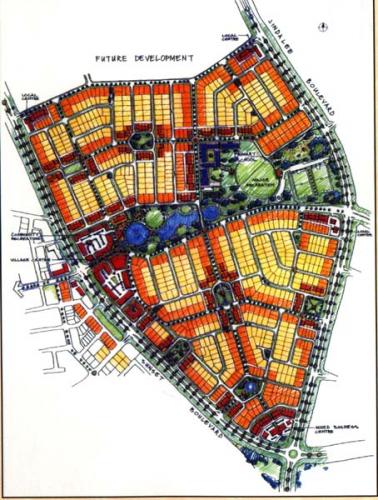
Liveable Neighbourhoods Community Design Code, Western Australia - Plan
Location: Western Australia, Australia. State
A-13/Liveable Neighbourhoods Community Design Code
With a million square miles of land, the state of Western Australia is almost the size of the United States west of the Great Divide. Most of the state's 2 million residents live in the rapidly sprawling area around Perth. During the 1990s, the public and government began looking for alternatives to Perth’s low-density suburban development, high car dependence and limited access to public transportation.
In response to these concerns, the state government developed the Liveable Neighbourhoods Code, based on the principles of New Urbanism and Responsive Environments practices from the United Kingdom. The code was developed through an extensive public process that included design charrettes for the entire Perth region.
“An inclusive and holistic process has made this plan one of the most thorough and ambitious new urbanist efforts anywhere in the world,” says juror Harvey Gantt.
Championed by the Western Australian government, the Code presents developers with a credible and marketable alternative to conventional suburban planning. The Code’s mandatory design process achieves the Charter of the New Urbanism’s principles of a clear urban framework at three levels: regional structure, neighborhood layout, and street and lot design. According to its government creators, the plan aims "to achieve a transformation in Western Australian urban planning, from the conventional suburban model to New Urbanism."
The state code applies to all urban fringe and major infill development projects. Its goals include economic, social and environmental sustainability; improved jobs-housing-transportation balance; and subdivision design that is sensitive to both regional climate and good design.
The code has six interrelated elements: community design; movement network; lot layout; public parkland; urban water management; and utilities.
Juror Anne Vernez-Moudon says, “This is an extremely thorough code spanning all scales of the New Urbanism.”
For example, the Community Design element defines towns as clusters of neighborhoods. These towns have at most an 800-meter (1/2-mile) walk to the center, and neighborhoods have half that radius. In addition to such technical prescriptions, the code also demands site-responsive architecture that respects the architectural and natural history of the area. The Community Design section lays out arterial routes, mass transit lines, and land uses in an attempt to improve local self-sufficiency and the jobs-housing balance. To create jobs in largely residential suburbs, the code includes economic development strategies such as home-based business development on busy streets with good commercial exposure and access.
Similiar levels of detail and care have gone into the five other major elements, resulting in a new urbanist code that is uniquely integrated in its response to architectural, natural, and economic needs. Walkable streets provide for the needs of people with disabilities and accommodate utilities and mass transit. Smaller, dense lot arrangements are required near town centers, at view locations, and adjacent to local parks. Regional parks are planned for the spaces between neighborhoods and towns. Parkland is also used for water management, providing swales to help recharge aquifers after the region's drenching rains.
In its three-year trial period, the code has enjoyed tremendous success with both the development industry and consumers. About 90,000 lots are in design according to the Code, in a market that produces about 12,000 units per year. The code has helped development practices in Western Australia evolve, particularly promoting Main Street retailing rather than shopping centres; small lot and site responsive housing rather than low-density ‘benched’ development; balanced transport planning rather than car-dominated suburbia; and mixed-use development rather than broad-brush zoning.
Project: Liveable Neighbourhoods, a set of statewide plans and codes for Western Australia
Site: Western Australia, a 1 million square mile state of Australia
Program: Reorient sprawl development around Perth into a series of towns that are based on walkable, compact neighborhoods. Enhance the feasibility of transit, increase quality of life, and enhance economic viability.
Public Agency: Western Australia Ministry for Planning
Consultants: Taylor Burrell, ESD Pty Ltd
Transect Zone(s): T1 preserve.
Status: <Unknown>
Project or Plan's Scale: Region
Land area (in acres): 640000000
Total built area (in sq. ft.):
Total project cost (in local currency):
Retail area (in sq. ft.):
Office area (in sq. ft.):
Industrial area (in sq. ft.):
Number of hotel units:
Number of residential units (include live/work):
Parks & green space (in acres):
Project team designers: Ministry for Planning, Western Australia
Project team developers: Taylor Burrell, Ecologically Sustainable Design
Previous site status:
Starting/Ending date of construction/implementation: -


